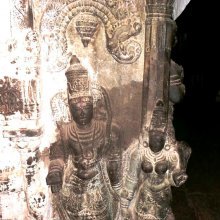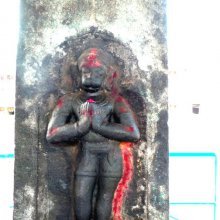Abhanga, Ābhaṅga, Abhaṅga, Abhamga: 7 definitions
Introduction:
Abhanga means something in Hinduism, Sanskrit, Marathi. If you want to know the exact meaning, history, etymology or English translation of this term then check out the descriptions on this page. Add your comment or reference to a book if you want to contribute to this summary article.
Images (photo gallery)
(+39 more images available)
In Hinduism
Shilpashastra (iconography)
Source: Google Books: The Book of Hindu Imagery: Gods, Manifestations and Their MeaningAbhanga-asana; This standing position in which the body weight is supported by one leg, both feet standing on the ground, with knees stretched and the hip pushed out on the side which is not supporting the weight, represents the fact that the god is deep in thought. The word “abhanga” means: with one curve. There are also the “dvibhanga” and the “tribhanga”, respectively positions with two and three curves (hips, shoulders and neck), which indicate a beneficient mood, and the “atibhanga”, the tribhanga with sharp curves in the hips and shoulders, which indicates violent movement or sometimes even violence. This is Shiva’s position in some of his destructieve aspects.
Source: Shodhganga: The significance of the mūla-beras (śilpa)Abhaṅga (अभङ्ग) refers to one of the three types of bhaṅga (“inflexions of the body”) which is one of the three divisions of pratimālakṣaṇa (body postures of the icons), as defined according to texts dealing with śilpa (arts and crafs), known as śilpaśāstras.—The bend in the body of an icon is called bhaṅga (flexions or attitudes). Abhaṅga is that form of standing pose in which the plumbline or the centre line from the crown of the head to a point midway between the heels passes slightly to the right of the navel. The bhaṅgas play a vital role in the postures of the deities and also while depicting them in dance. [...] The atibhaṅga and the abhaṅga postures are found in dance practice, but there is no exact term given for these postures in dance.

Shilpashastra (शिल्पशास्त्र, śilpaśāstra) represents the ancient Indian science (shastra) of creative arts (shilpa) such as sculpture, iconography and painting. Closely related to Vastushastra (architecture), they often share the same literature.
Languages of India and abroad
Marathi-English dictionary
Source: DDSA: The Molesworth Marathi and English Dictionaryabhaṅga (अभंग).—m (S) A particular metrical composition in praise of the Deity, and usually in the Prakrit language; a hymn.
--- OR ---
abhaṅga (अभंग).—a S (a & bhaṅga Fracture.) Unbroken; infrangible; inviolate; inviolable.
Source: DDSA: The Aryabhusan school dictionary, Marathi-Englishabhaṅga (अभंग).—a Unbroken, inviolate. Of one mass, not made up of pieces. m A hymn, a species of metre.
Marathi is an Indo-European language having over 70 million native speakers people in (predominantly) Maharashtra India. Marathi, like many other Indo-Aryan languages, evolved from early forms of Prakrit, which itself is a subset of Sanskrit, one of the most ancient languages of the world.
Sanskrit dictionary
Source: DDSA: The practical Sanskrit-English dictionaryAbhaṅga (अभङ्ग).—a. Not broken &c.
-ṅgaḥ 1 Absence of fracture or defeat.
2) (In Rhet.) A variety of श्लेष (śleṣa) where another meaning is obtained without dividing the words (this corresponds to arthaśleṣa); S. D.644.
--- OR ---
Ābhaṅga (आभङ्ग).—A pose in which the idol is slightly bent. आभङ्ग-समभङ्गं चातिभङ्गं त्रिधा भवेत् (ābhaṅga-samabhaṅgaṃ cātibhaṅgaṃ tridhā bhavet) Mānasāra. 67.95.96. ग्रीवाभङ्गाभिरामम् (grīvābhaṅgābhirāmam) Ś.1.7.
Derivable forms: ābhaṅgam (आभङ्गम्).
[Sanskrit to German]
Sanskrit, also spelled संस्कृतम् (saṃskṛtam), is an ancient language of India commonly seen as the grandmother of the Indo-European language family (even English!). Closely allied with Prakrit and Pali, Sanskrit is more exhaustive in both grammar and terms and has the most extensive collection of literature in the world, greatly surpassing its sister-languages Greek and Latin.
Kannada-English dictionary
Source: Alar: Kannada-English corpusAbhaṃga (ಅಭಂಗ):—[adjective] "0"
--- OR ---
Abhaṃga (ಅಭಂಗ):—
1) [noun] the state or quality of being continuous; continuity.
2) [noun] the quality of being not broken.
3) [noun] he who is free from death or destruction; a man who cannot be defeated; an invincible man.
4) [noun] a kind of meter in Marāthi.
5) [noun] a posture, placing the palms on either flank with elbows stretched out.
Kannada is a Dravidian language (as opposed to the Indo-European language family) mainly spoken in the southwestern region of India.
See also (Relevant definitions)
Starts with: Abhamganushamga, Abhamgaviththala, Abhangashlesha.
Ends with (+114): Abhimanabhamga, Ajnabhanga, Akshabhanga, Angabhanga, Asabhanga, Avabhanga, Avaranabhamga, Balabalabijabhanga, Bhagavatatattvadipaprakashavaranabhanga, Bhavabhanga, Bhrabhanga, Cakrabhanga, Cangabhanga, Caranabhanga, Ceshtabhanga, Chatrabhanga, Chattrabhanga, Chhatrabhanga, Civarabhanga, Dandabhanga.
Full-text: Atibhanga, Abhamga, Abhang, Bhanga, Nishedhanem, Sthitakuncita, Lalita, Deha, Svadaramantrabheda, Nanda.
Relevant text
Search found 13 books and stories containing Abhanga, Ābhaṅga, Abhaṅga, Abhamga, Abhaṃga; (plurals include: Abhangas, Ābhaṅgas, Abhaṅgas, Abhamgas, Abhaṃgas). You can also click to the full overview containing English textual excerpts. Below are direct links for the most relevant articles:
Sahitya-kaumudi by Baladeva Vidyabhushana (by Gaurapada Dāsa)
Text 9.35 < [Chapter 9 - Ornaments of Sound]
Text 9.2 < [Chapter 9 - Ornaments of Sound]
Text 9.31 < [Chapter 9 - Ornaments of Sound]
Jain Remains of Ancient Bengal (by Shubha Majumder)
Pañca-tīrthika type of Candraprabha sculptures < [Chapter 6 - Iconographic Study of Jaina Sculptural Remains]
Planatary Deities type of Śāntinātha Sculptures < [Chapter 6 - Iconographic Study of Jaina Sculptural Remains]
Single depiction of Pārśvanātha sculptures < [Chapter 6 - Iconographic Study of Jaina Sculptural Remains]
Temples of Munnur (Historical Study) (by R. Muthuraman)
Images of Dvarapalas < [Chapter 5]
Manasara (English translation) (by Prasanna Kumar Acharya)
Gati in Theory and Practice (by Dr. Sujatha Mohan)
Gati in classical dance form of Oḍissi < [Chapter 4 - Practice of Gati]
Related products






